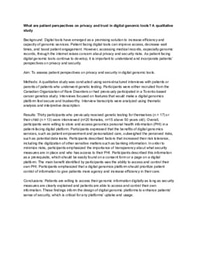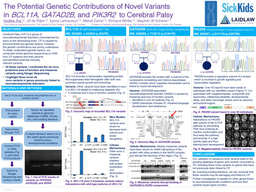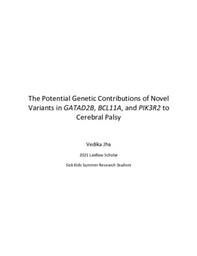Summer 2 Poster: What are patient perspectives on privacy and trust in digital genomic tools? A qualitative study
Background: Digital tools have emerged as a promising solution to increase efficiency and capacity of genomic services. Patient facing digital tools can improve access, decrease wait times, and boost patient engagement. However, accessing medical records, especially genomic records, through the internet raises concern about privacy and security risks. As patient facing digital genomic tools continue to develop, it is important to understand and incorporate patients’ perspectives on privacy and security.
Aim: To assess patient perspectives on privacy and security in digital genomic tools.
Methods: A qualitative study was conducted using semi-structured interviews with patients or parents of patients who underwent genetic testing. Participants were either recruited from the Canadian Organization of Rare Disorders or had previously participated in a Toronto-based cancer genetics study. Interviews focused on features that would make a digital genomics platform feel secure and trustworthy. Interview transcripts were analyzed using thematic analysis and interpretive description.
Results: Thirty participants who previously received genetic testing for themselves (n = 17) or their child (n = 13) were interviewed (n=20 females, n=15 above 50 years old). Overall, participants were willing to store and access genomics personal health information (PHI) in a patient-facing digital platform. Participants expressed that the benefits of digital genomics services, such as patient empowerment and personalized care, outweighed the perceived risks, such as potential data leaks. Participants described factors that increased their risk tolerance, including the digitization of other sensitive matters such as banking information. In order to minimize risks, participants emphasized the importance of transparency about what security measures are in place and who has access to their PHI. Participants described this information as a prerequisite, which should be easily found on a consent form or a page on a digital platform. The main benefit identified by participants was the ability to access and control their own PHI. Participants emphasized that a digital genomics platform should prioritize patient control of information to give patients more agency and increase efficiency in their care.
Conclusions: Patients are willing to access their genomic information digitally as long as security measures are clearly explained and patients are able to access and control their own information. These findings inform the design of digital genomic platforms to enhance patients’ sense of security, which is critical for any platforms’ uptake and usage.




Please sign in
If you are a registered user on Laidlaw Scholars Network, please sign in